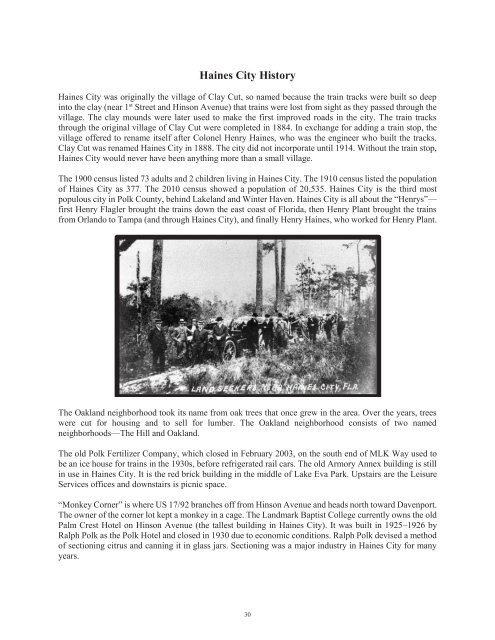City of Haines City Florida
FY-2016-BUDGET-Printed-to-pdf
FY-2016-BUDGET-Printed-to-pdf
- No tags were found...
Create successful ePaper yourself
Turn your PDF publications into a flip-book with our unique Google optimized e-Paper software.
<strong>Haines</strong> <strong>City</strong> History<br />
<strong>Haines</strong> <strong>City</strong> was originally the village <strong>of</strong> Clay Cut, so named because the train tracks were built so deep<br />
into the clay (near 1 st Street and Hinson Avenue) that trains were lost from sight as they passed through the<br />
village. The clay mounds were later used to make the first improved roads in the city. The train tracks<br />
through the original village <strong>of</strong> Clay Cut were completed in 1884. In exchange for adding a train stop, the<br />
village <strong>of</strong>fered to rename itself after Colonel Henry <strong>Haines</strong>, who was the engineer who built the tracks.<br />
Clay Cut was renamed <strong>Haines</strong> <strong>City</strong> in 1888. The city did not incorporate until 1914. Without the train stop,<br />
<strong>Haines</strong> <strong>City</strong> would never have been anything more than a small village.<br />
The 1900 census listed 73 adults and 2 children living in <strong>Haines</strong> <strong>City</strong>. The 1910 census listed the population<br />
<strong>of</strong> <strong>Haines</strong> <strong>City</strong> as 377. The 2010 census showed a population <strong>of</strong> 20,535. <strong>Haines</strong> <strong>City</strong> is the third most<br />
populous city in Polk County, behind Lakeland and Winter Haven. <strong>Haines</strong> <strong>City</strong> is all about the “Henrys”—<br />
first Henry Flagler brought the trains down the east coast <strong>of</strong> <strong>Florida</strong>, then Henry Plant brought the trains<br />
from Orlando to Tampa (and through <strong>Haines</strong> <strong>City</strong>), and finally Henry <strong>Haines</strong>, who worked for Henry Plant.<br />
The Oakland neighborhood took its name from oak trees that once grew in the area. Over the years, trees<br />
were cut for housing and to sell for lumber. The Oakland neighborhood consists <strong>of</strong> two named<br />
neighborhoods—The Hill and Oakland.<br />
The old Polk Fertilizer Company, which closed in February 2003, on the south end <strong>of</strong> MLK Way used to<br />
be an ice house for trains in the 1930s, before refrigerated rail cars. The old Armory Annex building is still<br />
in use in <strong>Haines</strong> <strong>City</strong>. It is the red brick building in the middle <strong>of</strong> Lake Eva Park. Upstairs are the Leisure<br />
Services <strong>of</strong>fices and downstairs is picnic space.<br />
“Monkey Corner” is where US 17/92 branches <strong>of</strong>f from Hinson Avenue and heads north toward Davenport.<br />
The owner <strong>of</strong> the corner lot kept a monkey in a cage. The Landmark Baptist College currently owns the old<br />
Palm Crest Hotel on Hinson Avenue (the tallest building in <strong>Haines</strong> <strong>City</strong>). It was built in 1925–1926 by<br />
Ralph Polk as the Polk Hotel and closed in 1930 due to economic conditions. Ralph Polk devised a method<br />
<strong>of</strong> sectioning citrus and canning it in glass jars. Sectioning was a major industry in <strong>Haines</strong> <strong>City</strong> for many<br />
years.<br />
30


